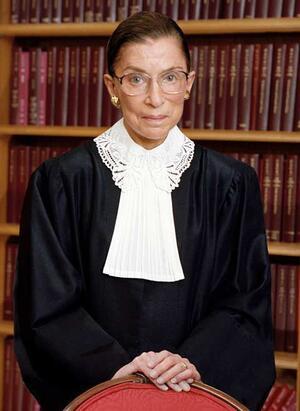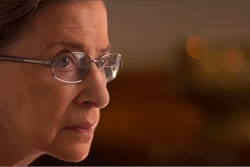RBG: Icon and Bubbe
I never knew how much I needed to see Ruth Bader Ginsburg laughing at Kate McKinnon’s SNL impression of her until I saw the legendary feminist icon lounging in a chair and chuckling at McKinnon pounding Emergen-C and declaring “I am going to live forever.”
This is just one moment in which the larger-than-life icon and the real person behind “RBG” collide in Betsy West’s and Julia Cohen’s inspiring documentary, RBG—a documentary about the legal architect of the feminist revolution and the first Jewish woman (second woman overall) to sit on the Supreme Court.
The film is thought-provoking, visually soothing, and masterfully edited. RBG’s impact on successive generations of women is celebrated through the intergenerational conversations Ginsburg has with her granddaughter––a Harvard Law School grad who lovingly refers to the Supreme Court justice as Bubbe.
The film traces her transformation from a young Jewish girl in Brooklyn, to an intrepid lawyer with impressive credentials who can’t get a job because of her gender, to her pioneering work against sex discrimination, to her Supreme Court confirmation hearings in 1993, to her current status as a veteran justice, cultural icon, and bubbe. Younger women may know more about RBG’s more recent work, but the film emphasizes how her early work in the 1960s and ‘70s totally changed life for American women in fundamental ways. (For example, women today don’t need a husband or father to co-sign our credit card applications!)
Ruth Bader Ginsburg works hard. In the film, her children lovingly and proudly recount their mom’s schedule, which she still maintains at 84: she works in the office until 8 or 9 p.m., then comes home and continues working until around 4 in the morning. Let me repeat that: she regularly works until 4 a.m. No wonder she falls asleep during the State of the Union!
This openness about RBG’s lack of a work-life balance lifts the curtain on what it takes to do her job well. She has had to make serious choices about how she spends her time. Because RBG is human (surprise!), it’s simply not possible that she could have been the perfect lawyer, most accommodating spouse, and attentive parent (not that she is or was bad at any of those things!). We have all benefited from her willingness to prioritize her work. It’s a lesson to all of us about what focused dedication can achieve, and what it costs.
In a time when women’s “wifely duties” were meant to be prioritized over their career aspirations, it was RBG’s husband who stepped aside, taking up the bulk of the domestic work so that Ruth could focus on her career. It can be difficult for younger women to digest this idea that Ruth needed a husband who “allowed” her to prioritize her work over her family. While women never need anyone’s permission to pursue their passions, Ruth would simply not have been able to succeed at such a high level if her husband hadn’t been so enthusiastically supportive, and so willing to assume the majority of the homemaking responsibilities.
Marty Ginsburg, Ruth’s husband of 53 years, is the sweetheart of the documentary. Marty, who passed away in 2010, provides the best moments of levity in the film. The viewer learns that it was Marty who cajoled a hardworking Ruth to come home for dinner most nights, and who passionately campaigned for her to win the Supreme Court nomination in 1993.
On the one hand, it’s gratifying and humanizing to see the obvious love and respect that these two intelligent, ambitious, and hardworking people had for each other. On the other, their relationship receives more screen time than RBG’s landmark Supreme Court wins, and that is somewhat problematic.
In addition to the disproportionate amount of screen time given to RBG’s marriage, I also noticed one glaring omission. As I watched Joe Biden respectfully question RBG during her Supreme Court hearing, I couldn’t help thinking about Anita Hill, who also underwent questioning under Biden, in 1991. Even though the journalist who covered the Hill story, Nina Totenberg, is a featured part of the documentary, and reflects on her relationship with RBG and their work on sexual discrimination, Hill’s name is not mentioned in the film.
In the age of #MeToo, this omission feels inadmissible, especially when Clarence Thomas sits comfortably on the Supreme Court bench alongside RBG.
While imperfect in some ways, the film’s authentic and humanizing representation of Ginsburg provides audiences with a comprehensive look into this icon’s remarkable life. The film ends with RBG speaking to a group of young students—her work and her life serving as a reminder to all of us that everyone deserves the dignity of equality under the law, supportive friends and family, and the opportunity to work towards our visions of a more just world.







